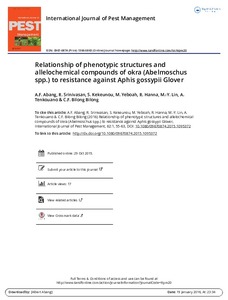| dc.contributor.author | Abang, A.F. |
| dc.contributor.author | Srinivasan, R. |
| dc.contributor.author | Kekeunou, S. |
| dc.contributor.author | Yeboah, M. |
| dc.contributor.author | Hanna, R. |
| dc.contributor.author | Lin, M.Y. |
| dc.contributor.author | Tenkouano, A. |
| dc.contributor.author | Bilong-Bilong, C.F. |
| dc.date.accessioned | 2019-12-04T11:04:07Z |
| dc.date.available | 2019-12-04T11:04:07Z |
| dc.date.issued | 2016 |
| dc.identifier.citation | Abang, A.F., Srinivasan, R., Kekeunou, S., Yeboah, M., Hanna, R., Lin, M.Y., ... & Bilong Bilong, C.F. (2016). Relationship of phenotypic structures and allelochemical compounds of okra (Abelmoschus spp.) to resistance against Aphis gossypii Glover. International Journal of Pest Management, 62(1), 55-63. |
| dc.identifier.issn | 0967-0874 |
| dc.identifier.uri | https://hdl.handle.net/20.500.12478/1343 |
| dc.description | Published online: 29 Oct 2015 |
| dc.description.abstract | The cotton aphid (Aphis gossypii) is one of the major pests of okra. Eleven okra varieties collected from farmers’ fields in
Cameroon and four aphid-resistant accessions from The World Vegetable Center (AVRDC, Asian Vegetable Research and
Development Center) were evaluated from October 2012 to March 2013, and another seven aphid-resistant accessions from
AVRDC were evaluated from March to July 2013 at AVRDC’s Nkolbisson station, Yaound e, Cameroon. Accessions
selected from these trials were screened in an advanced confirmatory screening in autumn (October December) 2013 in
Shanhua, Taiwan. Results showed that none of the farmers’ landraces were resistant to aphids. Two accessions (VI041210
and VI033824) with the lowest aphid populations had the highest trichome density. Analysis of various phytochemicals in
selected okra accessions revealed that higher nitrogen and potassium levels made the okra accessions susceptible to aphids
during the reproductive stage of the plants. Similarly, the total phenol content was lower in moderately resistant accessions
during their reproductive stage. Aphid feeding induced an increase in phenols, and to a lesser extent, tannins. Accessions
VI041210 and VI033824 could be incorporated into an integrated pest management strategy to enhance productivity of okra. |
| dc.format.extent | 55-63 |
| dc.language.iso | en |
| dc.subject | Resistance |
| dc.subject | Okra |
| dc.subject | Aphids |
| dc.subject | Allelochemicals |
| dc.subject | Abelmoschus |
| dc.title | Relationship of phenotypic structures and allelochemical compounds of okra (Abelmoschus spp.) to resistance against Aphis gossypii Glover |
| dc.type | Journal Article |
| dc.description.version | Peer Review |
| cg.contributor.crp | Integrated Systems for the Humid Tropics |
| cg.contributor.affiliation | World Vegetable Center |
| cg.contributor.affiliation | Université de Yaoundé |
| cg.contributor.affiliation | International Institute of Tropical Agriculture |
| cg.coverage.region | Africa |
| cg.coverage.region | Central Africa |
| cg.coverage.region | East Asia |
| cg.coverage.country | Cameroon |
| cg.coverage.country | Taiwan |
| cg.researchtheme | PLANT PRODUCTION & HEALTH |
| cg.isijournal | ISI Journal |
| cg.authorship.types | CGIAR and developing country institute |
| cg.iitasubject | Pests Of Plants |
| cg.iitasubject | Plant Health |
| cg.journal | International Journal of Pest Management |
| cg.howpublished | Formally Published |
| cg.accessibilitystatus | Limited Access |
| local.dspaceid | 79307 |
| cg.targetaudience | Scientists |
| cg.identifier.doi | https://dx.doi.org/10.1080/09670874.2015.1095372 |

